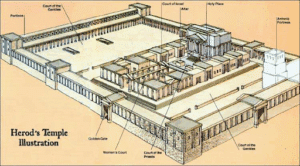In February, 1998, my husband went to an upper floor of the Denver Library to observe one million excited Broncos fans in Denver’s Civic Center area as they swarmed the newly crowned NFL Super Bowl champions.
The mood of that celebration hints at the joyous and sometimes volatile atmosphere of first century Jerusalem during yearly Passover festivals. Flavius Josephus, a Jewish historian of that time, estimated the city’s usual population of 100,000 – 200,000 would swell significantly, as high as one million due to the influx of Jewish pilgrims from around the world. Roman occupiers, stationed around the city and perched above Herod’s magnificently constructed Temple, were on extreme alert while as many as 400,000 worshippers crowded the most immense, awe-inspiring Temple plaza of ancient times.

Envision Jesus entering that Passover crowd at the ultra sacred bazaar curated by the high priest Annas’ family within the 35 acre Court of the Gentiles. In a thoroughgoing rout, Jesus took a multicorded whip and herded the exorbitantly expensive, unblemished animals out of the area. He then overturned tables of Roman currency marked with the image of Caesar that was being exchanged for coins acceptable for paying the Temple tax, scattering them in every direction.
Today, visitors to entertainment or convocation venues and religious sites (i.e. theme parks, sports contests, Mecca, the Vatican) spend substantial sums to relish the rarified atmosphere of those settings – purchasing housing, clothing, food and keepsakes for inflated prices. But some celebrants settle for more reasonably priced items from street merchants. Likewise, during the Passovers of that time, many other bazaars located just outside the Temple and all over the city offered the same products at a lower price than vendors controlled by Annas in that elite area inside the Temple.
So why did Jesus pick the elite area as his target for cleansing? It’s not hard to ascertain. These are his words of Messianic authority, starting with the vendors:
“Get these out of here! Stop turning my Father’s house into a market!”
The Jews [Annas’ cohort] then responded to him, “What sign can you show us to prove your authority to do all this?”
Jesus answered them, “Destroy this temple [his body], and I will raise it again in three days.” John 2:16, 18-19 NIV
Although several layers of authority – the Temple guards, the Roman soldiers or even Annas’ family cartel, could have intervened to physically stop Jesus from acting; no one did so. This resembles an earlier situation in Nazareth where Jesus also affirmed his divine identity.
They [Jewish leaders] got up, drove him out of the town, and took him to the brow of the hill on which the town was built, in order to throw him off the cliff. But he walked right through the crowd and went on his way. Luke 4:29-30 NIV
So that Passover, Jesus delivered his brief, pointed sermon to a large, miraculously hushed crowd. He reminded everyone that his Father, the God of Israel, historically and consistently voiced his desire to draw worshipers to Himself from the Gentile nations through His people. The Court of the Gentiles was a massive size for that reason.
Jesus still longs to add more worshippers to His Forever Family. Unfortunately, greedy, corrupt religious leaders (like Annas), still muddy the waters. Like the Jewish pilgrims of Jesus’ day, average Christians struggle with inviting others to worship the One, True God. Reasons include fear of being unworthy, discomfort with being turned down, inability to provide clever answers to big questions, and that old enemy, complacency. Today, meditate on the miraculous hush of the Passover crowd – identify what blocks you from inviting others to enjoy His Kingdom.
by Kathleen Petersen

